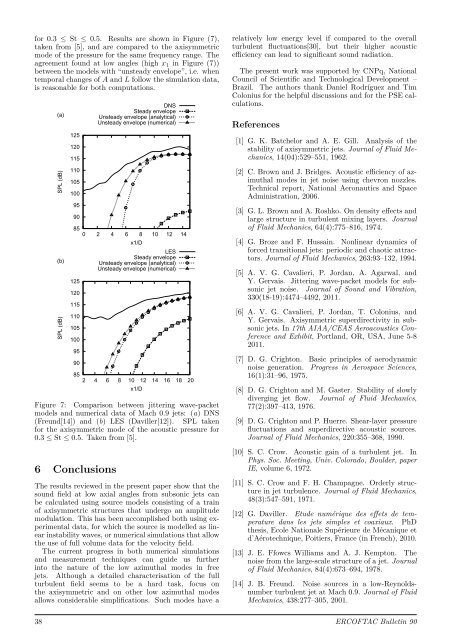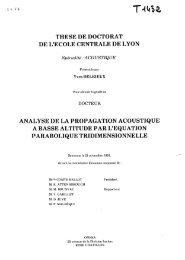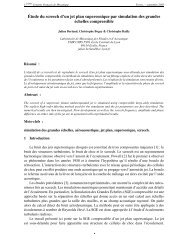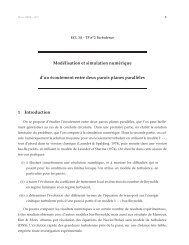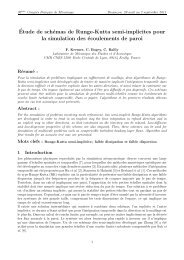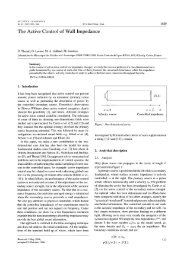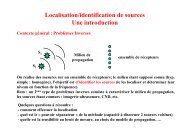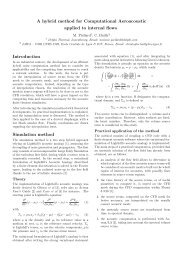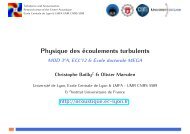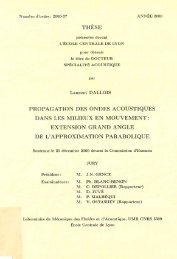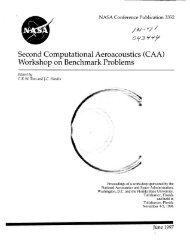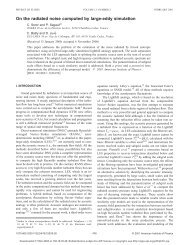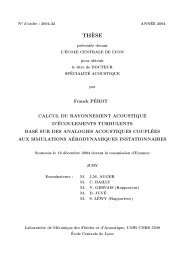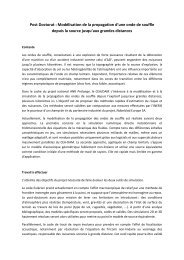ERCOFTAC Bulletin - Centre Acoustique
ERCOFTAC Bulletin - Centre Acoustique
ERCOFTAC Bulletin - Centre Acoustique
You also want an ePaper? Increase the reach of your titles
YUMPU automatically turns print PDFs into web optimized ePapers that Google loves.
for 0.3 ≤ St ≤ 0.5. Results are shown in Figure (7),<br />
taken from [5], and are compared to the axisymmetric<br />
mode of the pressure for the same frequency range. The<br />
agreement found at low angles (high x1 in Figure (7))<br />
between the models with “unsteady envelope”, i.e. when<br />
temporal changes of A and L follow the simulation data,<br />
is reasonable for both computations.<br />
(a)<br />
SPL (dB)<br />
(b)<br />
SPL (dB)<br />
125<br />
120<br />
115<br />
110<br />
105<br />
100<br />
95<br />
90<br />
DNS<br />
Steady envelope<br />
Unsteady envelope (analytical)<br />
Unsteady envelope (numerical)<br />
85<br />
0 2 4 6 8 10 12 14<br />
125<br />
120<br />
115<br />
110<br />
105<br />
100<br />
95<br />
90<br />
x1/D<br />
LES<br />
Steady envelope<br />
Unsteady envelope (analytical)<br />
Unsteady envelope (numerical)<br />
85<br />
2 4 6 8 10 12 14 16 18 20<br />
x1/D<br />
Figure 7: Comparison between jittering wave-packet<br />
models and numerical data of Mach 0.9 jets: (a) DNS<br />
(Freund[14]) and (b) LES (Daviller[12]). SPL taken<br />
for the axisymmetric mode of the acoustic pressure for<br />
0.3 ≤ St ≤ 0.5. Taken from [5].<br />
6 Conclusions<br />
The results reviewed in the present paper show that the<br />
sound field at low axial angles from subsonic jets can<br />
be calculated using source models consisting of a train<br />
of axisymmetric structures that undergo an amplitude<br />
modulation. This has been accomplished both using experimental<br />
data, for which the source is modelled as linear<br />
instability waves, or numerical simulations that allow<br />
the use of full volume data for the velocity field.<br />
The current progress in both numerical simulations<br />
and measurement techniques can guide us further<br />
into the nature of the low azimuthal modes in free<br />
jets. Although a detailed characterisation of the full<br />
turbulent field seems to be a hard task, focus on<br />
the axisymmetric and on other low azimuthal modes<br />
allows considerable simplifications. Such modes have a<br />
relatively low energy level if compared to the overall<br />
turbulent fluctuations[30], but their higher acoustic<br />
efficiency can lead to significant sound radiation.<br />
The present work was supported by CNPq, National<br />
Council of Scientific and Technological Development –<br />
Brazil. The authors thank Daniel Rodríguez and Tim<br />
Colonius for the helpful discussions and for the PSE calculations.<br />
References<br />
[1] G. K. Batchelor and A. E. Gill. Analysis of the<br />
stability of axisymmetric jets. Journal of Fluid Mechanics,<br />
14(04):529–551, 1962.<br />
[2] C. Brown and J. Bridges. Acoustic efficiency of azimuthal<br />
modes in jet noise using chevron nozzles.<br />
Technical report, National Aeronautics and Space<br />
Administration, 2006.<br />
[3] G. L. Brown and A. Roshko. On density effects and<br />
large structure in turbulent mixing layers. Journal<br />
of Fluid Mechanics, 64(4):775–816, 1974.<br />
[4] G. Broze and F. Hussain. Nonlinear dynamics of<br />
forced transitional jets: periodic and chaotic attractors.<br />
Journal of Fluid Mechanics, 263:93–132, 1994.<br />
[5] A. V. G. Cavalieri, P. Jordan, A. Agarwal, and<br />
Y. Gervais. Jittering wave-packet models for subsonic<br />
jet noise. Journal of Sound and Vibration,<br />
330(18-19):4474–4492, 2011.<br />
[6] A. V. G. Cavalieri, P. Jordan, T. Colonius, and<br />
Y. Gervais. Axisymmetric superdirectivity in subsonic<br />
jets. In 17th AIAA/CEAS Aeroacoustics Conference<br />
and Exhibit, Portland, OR, USA, June 5-8<br />
2011.<br />
[7] D. G. Crighton. Basic principles of aerodynamic<br />
noise generation. Progress in Aerospace Sciences,<br />
16(1):31–96, 1975.<br />
[8] D. G. Crighton and M. Gaster. Stability of slowly<br />
diverging jet flow. Journal of Fluid Mechanics,<br />
77(2):397–413, 1976.<br />
[9] D. G. Crighton and P. Huerre. Shear-layer pressure<br />
fluctuations and superdirective acoustic sources.<br />
Journal of Fluid Mechanics, 220:355–368, 1990.<br />
[10] S. C. Crow. Acoustic gain of a turbulent jet. In<br />
Phys. Soc. Meeting, Univ. Colorado, Boulder, paper<br />
IE, volume 6, 1972.<br />
[11] S. C. Crow and F. H. Champagne. Orderly structure<br />
in jet turbulence. Journal of Fluid Mechanics,<br />
48(3):547–591, 1971.<br />
[12] G. Daviller. Etude numérique des effets de temperature<br />
dans les jets simples et coaxiaux. PhD<br />
thesis, Ecole Nationale Supérieure de Mécanique et<br />
d’Aérotechnique, Poitiers, France (in French), 2010.<br />
[13] J. E. Ffowcs Williams and A. J. Kempton. The<br />
noise from the large-scale structure of a jet. Journal<br />
of Fluid Mechanics, 84(4):673–694, 1978.<br />
[14] J. B. Freund. Noise sources in a low-Reynoldsnumber<br />
turbulent jet at Mach 0.9. Journal of Fluid<br />
Mechanics, 438:277–305, 2001.<br />
38 <strong>ERCOFTAC</strong> <strong>Bulletin</strong> 90


